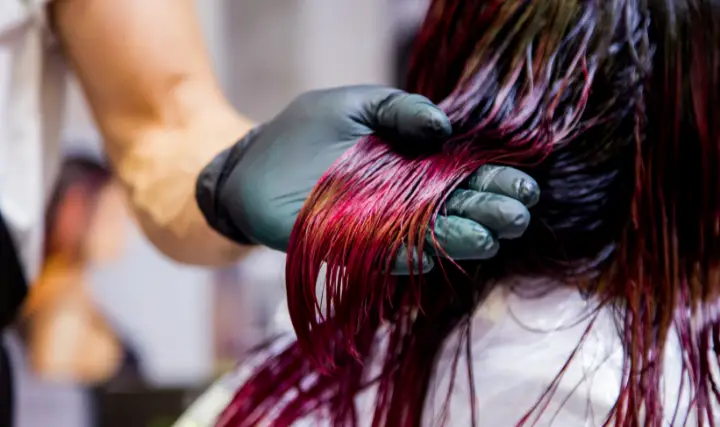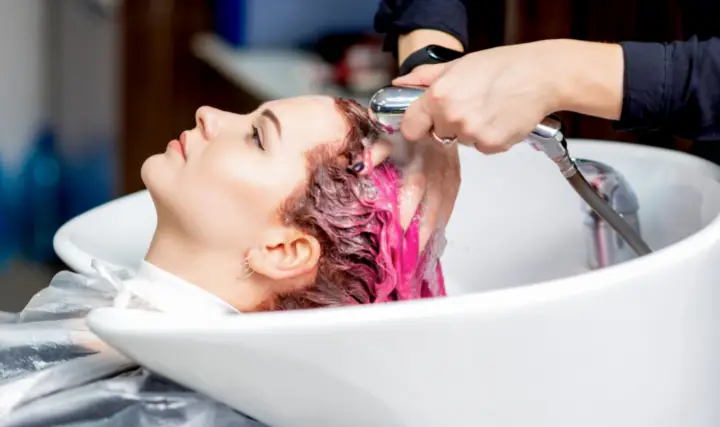For years now, the trend of colored hair has taken hold, and we’ve seen all sorts of colors: gray pearl, delicate pink highlights, blue hombre hair, gothic purple, fuchsia bombshell, and neon green.
Starting with Katy Perry, celebrities and fashion influencers have begun to flaunt the trendiest and craziest colors (some artists, actually, long before)!
This article is meant to be a complete guide on how to choose a Manic Panic color, how to apply the dye, how to maintain it over time, and how to remove the semi-permanent red hair color.

What are Manic Panic dyes?
Manic Panic dyes are semi-permanent hair colors.
These dyes do not need ammonia to be activated and are completely vegan and cruelty-free.
The coloring is done by covering and goes away after several washes without affecting or ruining the hair indeed: the colors all have a super nourishing, shining, and moisturizing effect on our hair.
Read: How To Wash Out Arctic Fox Hair Dye Easily
Step 1: Choosing a color.
There is a fundamental rule to keep in mind when choosing a color: the lighter the color, the greater the need to bleach the hair.
To achieve very light colors such as gray and lavender, i.e., light colors that have a completely cold base, it will be necessary to bleach the hair down to 10. Platinum.
The color of our hair, natural or artificial, is composed of blue, red, and yellow pigments in different percentages depending on our color.
Blue pigments are in a higher percentage in dark hair, while reds are in medium colors and yellow pigments characterize blondes.
Bleaching consists of canceling out this pigmentation, starting with blue, then moving on to red, and finally to yellow.
- Black
- Brown
- Dark brown
- Medium brown
- Light brown
- Dark blond
- Medium blond
- Light Blond
- Very light blond
- Platinum
Pastel, very light or very cool colors and purples need to find as light a base as possible.
In general, all colors reach optimal saturation on tone levels between 9.
Very light blonde and 10. Platinum, but don’t despair: there are plenty of colors that don’t need such extreme bleaching and look great even on natural or unbleached hair, perfect on medium or dark browns or red hair.
Read: How To Get Rid Of Semi Permanent Blue Hair Dye
Step 2: Decoloring
This step is optional, necessary only when you opt for pastel, light, or purple colors or when you want to achieve 100% color saturation and vividness.
To color, it is necessary to rely on a professional in order not to risk damaging or burning the hair.
Don’t underestimate the risks of bleaching: damaging the hair also means that the color may not take at all, as the scales are irreparably too open for it to take hold and may lead to drastically cutting the hair.
Bleaching requires manual skills, specific times, and knowledge that only a professional has.
In addition, to play with color or bleaching from the root, you need different types of products and know how to use them, know how to foresee the results, and have the readiness to react if the bleaching does not go according to plan.
Don’t rely on DIY if you don’t have this knowledge and the necessary products.
Important note about bleaching:
Be aware that after bleaching, if you opted for very light colors but didn’t achieve a 9/10 with bleaching, they will barely show, unfortunately.
This talk includes all pastels, light rosés, pearlescents that are always light. Cool-based colors such as green, light blue, and purple will take hold but will have a less saturated, more ashy hue.
Step 3: How to color your hair with Manic Panic colors
As mentioned above: Manic Panic colors do NOT need to be activated with oxygen but should be applied pure on clean, dry hair.
Cleansing your hair will help the color take hold (unlike standard colors, on which the sebum acts as a protector). Manic Panic colors have a nourishing, moisturizing, polishing effect. After application, you will have wonderful hair!
Essential accessory: gloves. You can apply the color as you prefer, brush, bouillotte (the latter I do not recommend in order not to waste color), or massage with your hands, but the gloves you can not give up because the colors are absorbed in-depth and wash them off is less simple than you think.
Arm yourself with a cape and apply an oil-based cream to your hairline.
Divide your hair into sections.
Put on your cape and gloves and apply a thin layer of protectant (or a grease-based cream such as Vaseline) to all of your hairlines (don’t forget your ears!), being careful not to get any dirt in your hair or the color won’t take.
Heat your hair with a hair dryer before applying the color: the heat will open up the scales, and the dye will take better hold.
Apply a generous amount of product, massaging the color between your fingers so that it takes root in an optimal way.
If you opt for total coverage of the hair, I recommend abounding with the color for a homogeneous result. In the case of playing with color and light with bleaching: the result will be more beautiful if you alternate saturated locks with lighter veils.
Step 4: Laying
Once you’ve finished applying the color, don’t underestimate the application time.
Basically, you need 45 minutes, but the more time you have to apply it, the better, the result will be, especially if it is the first time you do this color.
In case of very light colors, keep it in place as long as possible.
Fundamental to the pose is keeping the heat on the hair.
There are those who apply the transparent film, but I recommend wrapping the locks in aluminum foil, tightly closed, wearing a cap (the kind used in the shower), and bringing the heat with the hair dryer several times during the application time (without heating the aluminum too much to avoid burning hair and skin!).
Step 5: The Wash and Acid Rinse
Since you will have applied the color on clean hair, I do not recommend using shampoo at this stage.
Basic rules for rinsing are:
- Wash the hair only with cold water so as not to open the scales of the hair and lose too much color (with semi-perms, unfortunately, you have to completely forget about hot water even during color maintenance).
- Do not use shampoos with sodium lauryl \ laureth sulphate, sulphates in general and aggressive saponins, no oils, or lightening ingredients, opt for an organic shampoo.
- After washing your hair thoroughly, move on to acid rinsing.
- The acid rinse is done with water and apple cider vinegar and serves to close the scales of the hair, fixing the color and making the hair silky and shiny.
- The dosage for the acid rinse is 10/15ml of apple cider vinegar in 1lt of water.
- After washing the hair well, turn off the water and pass this solution over the entire hair, leaving it to act for a few minutes. Then pat dry with a towel.
- The vinegar smell will NOT remain on your hair, don’t worry!
Be careful with porous tiles when applying and rinsing the color: clean them immediately; otherwise, they will absorb the product, and it will be difficult to remove the stains.
If you have stains on your skin, you’ll need to use a shampoo or bath foam containing sulfates and aggressive saponins (those not recommended above, basically) mixed with baking soda.
The mixture should be 1:1, meaning 1 tablespoon of baking soda for every 1 of detergent.
Then proceed to the styling process.
Step 6: Maintaining and Lasting
Be patient: semi-permanent colors tend to fall out a lot, so you’ll stain your pillowcase and anything else you put your head on (including the neck of your shirts).
Keep in mind that the lighter the color you choose, the more often you’ll need to re-apply the color and keep it on as long as possible.
Light colors tend to fade from the first wash (opt for Amplified in case), unlike blues, greens, and reds which have excellent durability.
Light colors last on average 3/4 washes with proper maintenance.
Darker colors last up to a month, with an average of 2 washes per week before needing to reapply the color.
The important thing is to avoid harsh shampoos, always use acid rinses, avoid oily packs, and, if you can, it’s helpful to wash your hair as little as possible.
Do not worry: acid rinses and organic shampoos help keep it clean for much longer (bearing in mind, however, that organic shampoos need to be well diluted and well rinsed!).

Step 7: How To Remove the Red Semi Permanent color?
You are tired of the Manic Panic color and want to remove it or switch from a dark blue to a lighter one. How to remove the color?
The solutions are different: if you want to remove a very light color or if you do not want to remove it immediately, with washing, it will go away completely, leaving no trace.
If you’re not in a hurry: hot oil treatments, lacquers, alcohol and oil-based products, aggressive detergents (lightening shampoo, anti-dandruff or deep cleansing), warm water, and a 1:1 solution with shampoo and baking soda will remove everything.
To remove it right away: to remove the color in one fell swoop, it is the case to rely on experienced hands to perform this treatment!
Mix:
- 3 tablespoons of oxygen
- 2 tablespoons of bleach
- Plus 2 tablespoons of bleaching shampoo
- 2 tablespoons of mask or conditioner for dry hair
Put on a pair of gloves
Apply the mixture to wet hair, stopping about 2 inches away from your roots.
Work quickly and start kneading the mixture into your hair, starting from the ends to the roots.
Work this mixture on your hair for 5-10 minutes.
Wash the mixture out with lukewarm water.
Shampoo and mask for deep hydration.